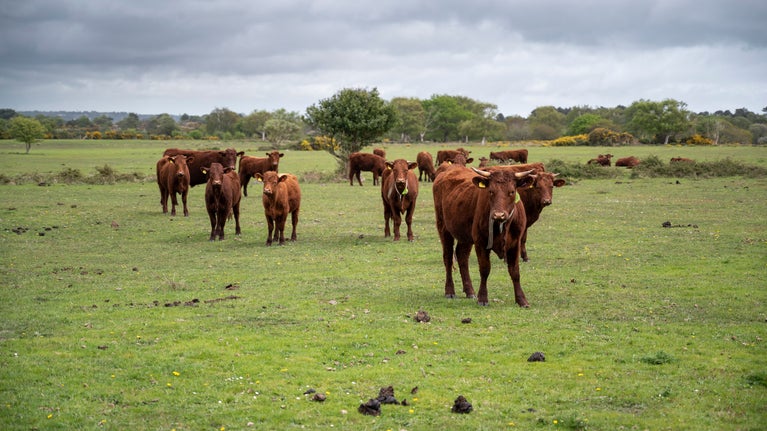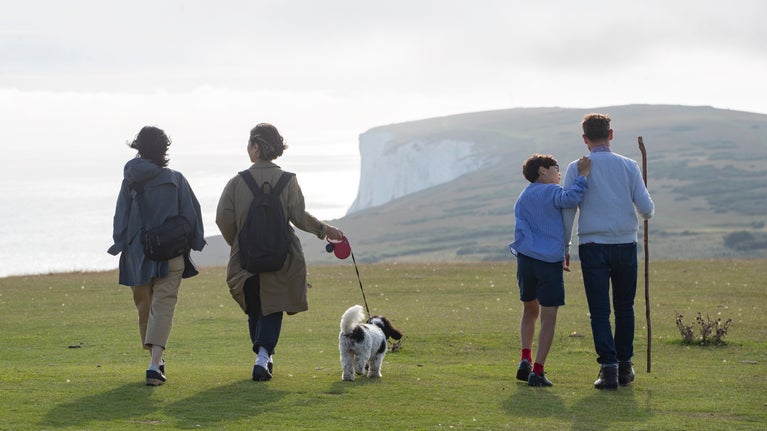Our Work on Tennyson Down
- Last updated:
- 01 July 2025

Jump to
- Why is grazing necessary on Tennyson Down?
- Can we see where the cattle are grazing?
- Containing the cattle
- Caring for the cattle
- Do the collars cause harm to the cattle?
- Can’t machinery control scrub without grazing?
- Are there other sites using No Fence collars?
- What happens when the collar batteries run low?
- How accurate is the virtual fence line?
- What if a dog chases cattle through the virtual fence?
- Are the collars comfortable for the cattle?
- Can the collars get caught on vegetation?
Tennyson Down is a special landscape for many reasons and our countryside team works all year round to keep it that way. One of our long-term ambitions is to restore more of Tennyson Down back to open chalk grassland.
Between the early 1900s and the 1990s there were no animals grazing on the Down. This allowed the whole of the sheltered north side of the Down to grow up with young woodland and many of the chalk grassland flowers and butterflies disappeared. In the 1990s cattle were gradually reintroduced and areas of young trees are being removed to allow the rare chalk grassland to return and once again provide a landscape of open downland rich in wildlife.
Why is grazing necessary on Tennyson Down?
Conservation grazing preserves chalk grassland habitats and increases biodiversity.
Browsing and grazing helps keep the right balance of chalk grassland, scattered scrub and woodland. Chalk grassland is such a rare and declining habitat that we need to focus on restoring it where we can.
Can we see where the cattle are grazing?
Yes. Initially, maps will show grazing areas and virtual fence lines. Eventually, QR codes will provide live updates to help plan walking routes. We plan to exclude cattle from the cliff top path on Tennyson Down so that there is a path along the cliff tops leading to and beyond the Tennyson monument that should be free of cattle.
Containing the cattle
The No Fence method uses modern technology to contain the cattle and each member of the herd wears a solar-powered GPS collar. If they approach the virtual boundary, they’re alerted by a musical tone and, if they persist, they’re deterred by a weak electrical pulse.
Cattle associate the musical tone with the approaching boundary and quickly learn to turn back before crossing it. The system was developed in Norway, where it’s been used on grazing animals for about 10 years.
Caring for the cattle
Our tenant farmer checks them regularly when out on the Down – their search is made easier thanks to the cattle’s GPS collars as their location can be seen on a mobile phone.
While the cattle have been picked for their calmness, we ask the public to take care if they encounter cattle. Please follow this guide below.
- Do not approach or feed the cattle.
- Keep dogs on short leads where cattle are grazing and if cattle approach let your dog off the lead.
- Pick up and remove dog waste and litter.
- Do not touch any equipment or cattle collars, due to the risk of electric pulse.
Do the collars cause harm to the cattle?
No. The cattle are gradually trained to respond to the collars in a stress-free environment. The collars use audio warnings and, if necessary, a weak electric pulse, much milder than traditional electric fences.
Can’t machinery control scrub without grazing?
We do use machinery for initial grassland restoration, but it's costly and unsustainable long-term. Cattle provide selective grazing that promotes habitat diversity more naturally and sustainably and the ability to create virtual fences will allow us to graze confidently in areas that have previously been too difficult or not appropriate to fence.

Are there other sites using No Fence collars?
Yes, sites in North Devon, Purbeck, Brean Down, Brighton and Hove, Woolbeding Farm, Pembrokeshire, and South Devon are already using them successfully.
What happens when the collar batteries run low?
The app sends a warning when batteries are low, allowing timely replacement. Each battery lasts several months.
How accurate is the virtual fence line?
The fence line is usually accurate within 5 metres but can vary up to 30 metres depending on satellite signal. We will ensure at least 30 metres of leeway back from the coast path along the cliff top.
What if a dog chases cattle through the virtual fence?
The system allows cattle to re-enter the grazing area without getting a shock. In line with the countryside code, we request that people do keep their dogs under close control to minimise the chance of livestock being chased, and to reduce the impact on wildlife such as ground nesting birds.
Are the collars comfortable for the cattle?
Yes. The collars are designed for comfort and to minimize rubbing, similar to cowbells worn in mountain regions.
Can the collars get caught on vegetation?
There is a small risk, but cattle can usually free themselves. Daily checks and app alerts ensure any issues are promptly addressed.
If you have any questions about the No Fence system and grazing on Tennyson Down please email isleofwight@nationaltrust.org.uk